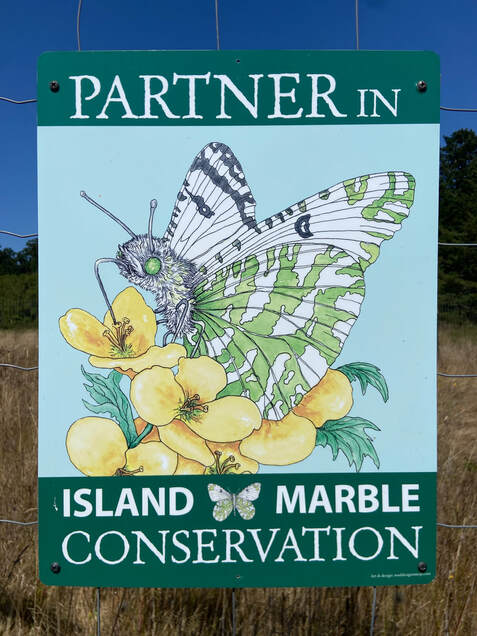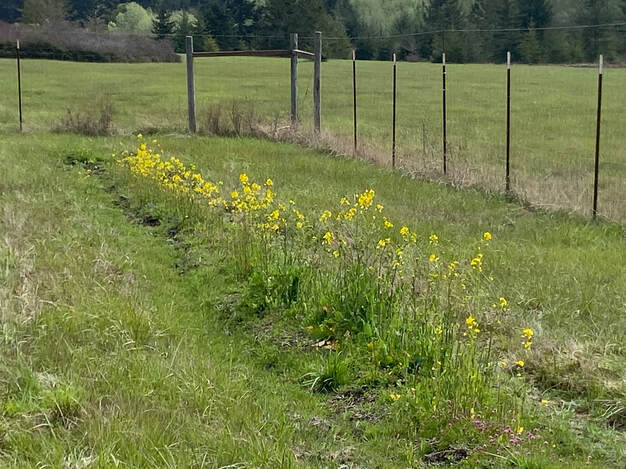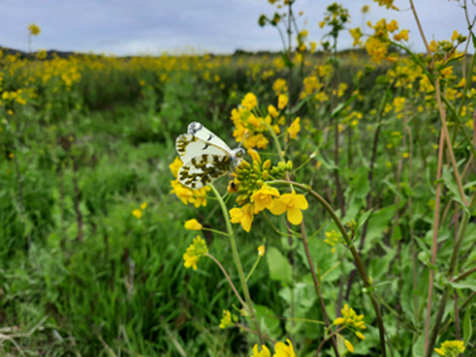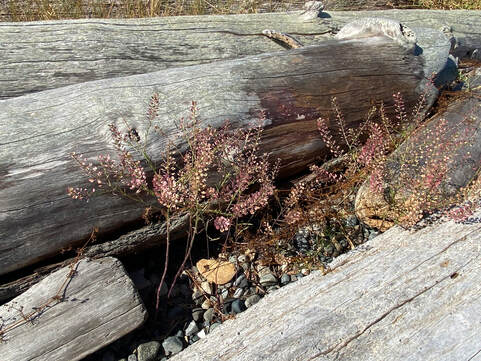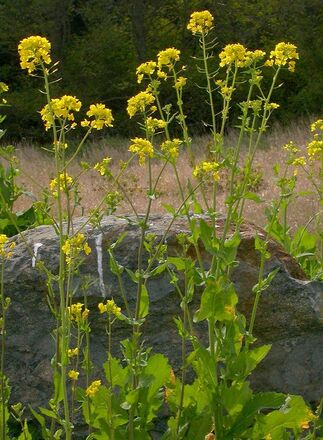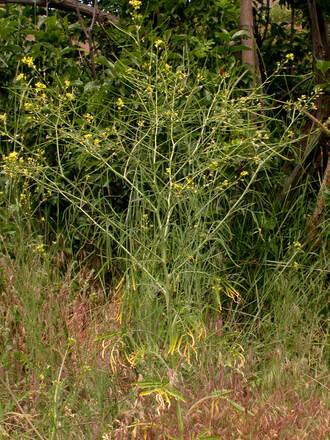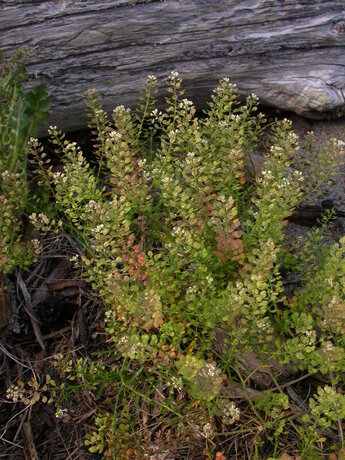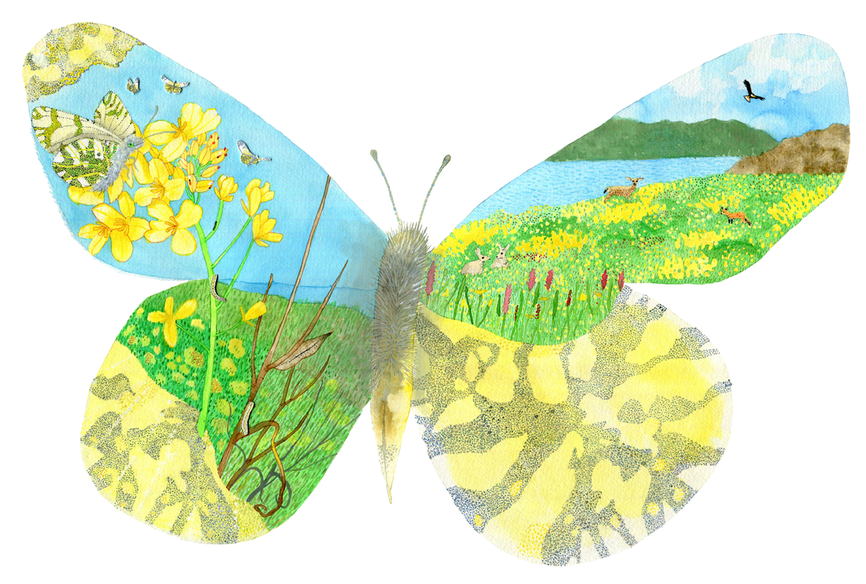Join Us in Recovery Efforts
Provide habitat for endangered the island marble butterfly. You can get involved in species recovery by volunteering to grow host plants in protected habitat areas, by adding habitat to your property, or by donating to support volunteers renewing annual host plants for butterflies.
Provide habitat for endangered the island marble butterfly. You can get involved in species recovery by volunteering to grow host plants in protected habitat areas, by adding habitat to your property, or by donating to support volunteers renewing annual host plants for butterflies.
Habitat Conservation
|
Deer-fenced Habitat Plots
Deer fencing is critical to protect eggs and young larvae from browsing deer and to provide stable, protected year-round habitat for chrysalises. It is important to both provide habitat to support the island marble butterfly's life cycle and to protect against sources of island marble butterfly loss. Field mustard, or Brassica rapa (shown below) is planted in habitat plots in grassland ecosystems.
Host Plants and Their Habitats
The island marble butterfly uses both introduced and native mustard host plants in several different environments. Over time, the butterfly has come to rely upon introduced, weedy species to complete its life cycle, while also relying on native host plants.
Introduced Host Plant Species
Introduced mustard are currently critical to supporting the life cycle and recovery of the island marble butterfly. In this context, mustard is beneficial to butterflies through island marble butterfly conservation. Weed control and invasive species eradication remain important.
Introduced mustard are currently critical to supporting the life cycle and recovery of the island marble butterfly. In this context, mustard is beneficial to butterflies through island marble butterfly conservation. Weed control and invasive species eradication remain important.
Disturbance
Disturbance is an important ecological process that can maintain biodiversity. Early succession annuals or biennials, like mustard, need disturbance to germinate and carry out their life cycle. Historically, disturbance has included fire, grazing, trampling, drought, and storms. Species can be adapted to disturbance. To promote mustard in habitat plots, various techniques are used to disturb the soil. Land managers also remove shrubs and trees encroaching into grasslands, use fire restoration treatments, and remove invasive species. This recent historical trend toward altered patterns of disturbance is a problem for imperiled butterfly species that rely on host plant availability in their environments.
Disturbance is an important requirement for island marble butterfly habitat. Volunteers are needed to actively work in the islands to create conditions for optimal host plant growth to expand habitat. Host plants must find the right conditions to grow in patches across the islands on a yearly basis. Due to the island marble butterfly's current status, combined needs for disturbance and host plant protection from deer results in the need for volunteers to cultivate mustard inside fenced habitats.
Disturbance is an important ecological process that can maintain biodiversity. Early succession annuals or biennials, like mustard, need disturbance to germinate and carry out their life cycle. Historically, disturbance has included fire, grazing, trampling, drought, and storms. Species can be adapted to disturbance. To promote mustard in habitat plots, various techniques are used to disturb the soil. Land managers also remove shrubs and trees encroaching into grasslands, use fire restoration treatments, and remove invasive species. This recent historical trend toward altered patterns of disturbance is a problem for imperiled butterfly species that rely on host plant availability in their environments.
Disturbance is an important requirement for island marble butterfly habitat. Volunteers are needed to actively work in the islands to create conditions for optimal host plant growth to expand habitat. Host plants must find the right conditions to grow in patches across the islands on a yearly basis. Due to the island marble butterfly's current status, combined needs for disturbance and host plant protection from deer results in the need for volunteers to cultivate mustard inside fenced habitats.
List of Island Marble Butterfly Nectar Plants
The island marble butterfly need sources of nectar to carry out their adult life stage as butterflies and reproduce. These coevolved relationships involve island marble butterfly pollinating nectar-producing plants in grassland, remnant prairie, dune, lagoon, and shoreline ecosystems. Pollinators are of vital importance to the plants they visit. This list provides an overview of nectar sources for the species.
yellow sand verbena, Abronia latifolia, native perennial
yarrow, Achillea millefolium, native and introduced populations, perennial, white-flowering—can be preferred for mating
small-flowered fiddleneck, Amsinckia menziesii, native annual
american sea rocket, Cakile edentula, introduced annual, bienniel, perennial
field chickweed, Cerastium arvense, native perennial, white-flowering—preferred for mating
common stork’s bill, Erodium cicutarium, introduced annual
dovefoot geranium, Geranium molle, introduced annual
hairy cat’s ear, Hypochaeris radicata, introduced perennial
common lomatium, Lomatium utriculatum, native perennial
seashore lupine, Lupinus littoralis, native perennial
common forget-me-not, Myosotis discolor, introduced annual
california buttercup, Ranunculus californicus, native perennial
trailing blackberry, Rubus ursinus, native perennial, white-flowering—can be preferred for mating
common dandelion, Taraxacum officinale, introduced perennial
death camas, Toxicoscordion venenosum, native perennial, white-flowering—can be preferred for mating
Howell’s brodiaea, Triteleia grandiflora var. howellii, native perennial
The island marble butterfly need sources of nectar to carry out their adult life stage as butterflies and reproduce. These coevolved relationships involve island marble butterfly pollinating nectar-producing plants in grassland, remnant prairie, dune, lagoon, and shoreline ecosystems. Pollinators are of vital importance to the plants they visit. This list provides an overview of nectar sources for the species.
yellow sand verbena, Abronia latifolia, native perennial
yarrow, Achillea millefolium, native and introduced populations, perennial, white-flowering—can be preferred for mating
small-flowered fiddleneck, Amsinckia menziesii, native annual
american sea rocket, Cakile edentula, introduced annual, bienniel, perennial
field chickweed, Cerastium arvense, native perennial, white-flowering—preferred for mating
common stork’s bill, Erodium cicutarium, introduced annual
dovefoot geranium, Geranium molle, introduced annual
hairy cat’s ear, Hypochaeris radicata, introduced perennial
common lomatium, Lomatium utriculatum, native perennial
seashore lupine, Lupinus littoralis, native perennial
common forget-me-not, Myosotis discolor, introduced annual
california buttercup, Ranunculus californicus, native perennial
trailing blackberry, Rubus ursinus, native perennial, white-flowering—can be preferred for mating
common dandelion, Taraxacum officinale, introduced perennial
death camas, Toxicoscordion venenosum, native perennial, white-flowering—can be preferred for mating
Howell’s brodiaea, Triteleia grandiflora var. howellii, native perennial
|
Contact Us
Island Marble Butterfly Volunteer Program San Juan Islands Conservation District 530 Guard St Friday Harbor, WA 98250 [email protected] (360) 375-3070 |
Giving to the Island Marble Butterfly Volunteer Program
Your gift benefits the island marble butterfly by helping to provide habitat for this endangered species. Stay in Touch!
Sign up for volunteer program updates. Thank you!You have successfully joined our subscriber list. |
Copyright © 2024 San Juan Islands Conservation District
ALL RIGHTS RESERVED
ALL RIGHTS RESERVED
